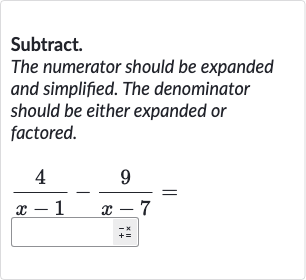Full solution
Q. Subtract.The numerator should be expanded and simplified. The denominator should be either expanded or factored.
- Identify Common Denominator: Identify the common denominator for the two fractions.In order to subtract the fractions, we need a common denominator. The common denominator for and is the product of the two, which is .
- Rewrite with Common Denominator: Rewrite each fraction with the common denominator.We need to adjust each fraction so that they both have the common denominator . This means multiplying the numerator and denominator of each fraction by the missing factor.For the first fraction, , we multiply the numerator and denominator by .For the second fraction, , we multiply the numerator and denominator by .
- Perform Multiplication: Perform the multiplication for each fraction.Now we multiply the numerators and denominators as planned in Step . becomes becomes
- Subtract Fractions: Subtract the two fractions.Now that both fractions have the same denominator, we can subtract the numerators and keep the common denominator.
- Expand and Simplify: Expand and simplify the numerator.We need to distribute the subtraction across the numerators.Now combine like terms.So the simplified numerator is .
- Write Final Expression: Write the final simplified expression.The final simplified expression is .
More problems from Negative Exponents
QuestionGet tutor help

